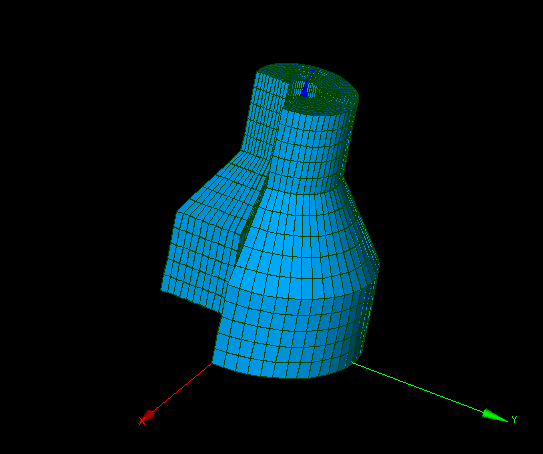Associate the model of blocks to the geometry¶
Elements association¶
Associate to a vertex of the geometry:
vx.setAssociation(geom_object_vertex)
Get the association:
gov = vx.getAssociation()
Associate to an edge or a wire of the geometry:
l = edg.addAssociation(geom_object_1D, debut, val)
Get the associations:
edge_associations = edg.getAssociations()
Associate to a face or a shell of the geometry:
l = quad.addAssociation(geom_object_2D)
Give the association:
go2d = quad.getAssociations()
Associate by lines¶
To associate an opened line to the geometry, the following data have to be mentioned:
- the starting edge of the model of blocks: mstart
- the list of edges of the model of blocks: mline
- the starting edge of the geometry: gstart
- the curvilinear abscissa on the starting edge of the geometry: pstart (double)
- the list of edges of the geometry: gline
- the curvilinear abscissa on the last edge of the geometry: pend
The number of edges of the model of blocks to associate may be different from the number of edges of the geometry.
Associate an opened line:
l = doc.associateOpenedLine(mstart, mline, gstart, pstart, gline, pend)
To associate a closed line to the geometry, the following data have to be mentioned:
- the starting vertex of the model of blocks: mfirst
- the starting edge of the model of blocks: mstart
- the list of edges of the model of blocks: mline
- the starting edge of the geometry: gstart
- the curvilinear abscissa on the starting edge of the geometry: pstart (double)
- the list of edges of the geometry: gline
The number of edges of the model of blocks to associate may be different from the number of edges of the geometry.
Associate a closed line:
l = doc.associateClosedLine(mfirst, mstart, mline, gstart, pstart, gline)
Note for face association¶
Face association (implicite or explicite) is not necessary for:
- planar faces,
- cylindrical faces,
- conical faces.
Only edges association (implicite) on segments or arcs of cirle is necessary.
The following example show a model of block on which there isn’t faces association but only implicite edges association on arcs of circle.
Example¶
1 2 3 4 5 6 7 8 9 10 11 12 13 14 15 16 17 18 19 20 21 22 23 24 25 26 27 28 29 30 31 32 33 34 35 36 37 38 39 40 41 42 43 44 45 46 47 48 49 50 51 52 53 54 55 56 57 58 59 60 61 62 63 64 65 66 67 68 | # -*- coding: latin-1 -*-
# Copyright (C) 2009-2016 CEA/DEN, EDF R&D
#
# This library is free software; you can redistribute it and/or
# modify it under the terms of the GNU Lesser General Public
# License as published by the Free Software Foundation; either
# version 2.1 of the License, or (at your option) any later version.
#
# This library is distributed in the hope that it will be useful,
# but WITHOUT ANY WARRANTY; without even the implied warranty of
# MERCHANTABILITY or FITNESS FOR A PARTICULAR PURPOSE. See the GNU
# Lesser General Public License for more details.
#
# You should have received a copy of the GNU Lesser General Public
# License along with this library; if not, write to the Free Software
# Foundation, Inc., 59 Temple Place, Suite 330, Boston, MA 02111-1307 USA
#
# See http://www.salome-platform.org/ or email : webmaster.salome@opencascade.com
#
import hexablock
doc = hexablock.addDocument ("test_cone")
orig = doc.addVertex (0, 0, 0)
ori2 = doc.addVertex (0, 0, 10)
vz = doc.addVector (0, 0, 1)
vx = doc.addVector (1 ,0, 0)
rad1 = 2.0
rad2 = 1.0
height = 5.0
angle = 270.0
hollow = False
nr = 2
na = 8
nl = 1
c1 = doc.makeCylindrical (orig, vx,vz, rad1, angle, height, nr,na,nl, hollow)
c2 = doc.makeCylindrical (ori2, vx,vz, rad2, angle, height, nr,na,nl, hollow)
vh0 = c2.getVertexIJK (0, 0, 0)
vh1 = c2.getVertexIJK (1, 0, 0)
vb0 = c1.getVertexIJK (0, 0, nl)
vb1 = c1.getVertexIJK (1, 0, nl)
qcible = c2.getQuadIJ (0, 0, 0)
qliste = []
for ni in range (nr) :
for nj in range (na) :
quad = c1.getQuadIJ (ni, nj, nl)
qliste.append (quad)
## Join quads to make a cone between the 2 cylinders
doc.joinQuads (qliste, qcible, vb0, vh0, vb1, vh1, 1)
### -------------------- Mesh
law = doc.addLaw ("Uniform", 4)
for np in range(doc.countPropagation()):
propa = doc.getPropagation (np)
propa.setLaw (law)
mesh_hexas = hexablock.mesh(doc)
|
